Though inhospitable and arid today, as early as a couple thousand years ago the Arabian Peninsula was a green, lush ecosystem that housed a far greater biodiversity than it currently does. Among the many species of carnivores and herbivores that dotted the landscape was a now-extinct elephant species called Elephas recki, which grew to be 50% larger than today’s African elephants.

E. recki occupied northern Africa and the Middle East from about 3.5 million years ago to 300,000 years ago, when it disappeared from fossil records. Given that it survived throughout the Pliocene and the Pleistocene, this was a rather successful species until — some speculate — it entered competition members of the genus Loxodonta, the African elephants of today. Its closest modern ancestor, however, is the Asian elephant.
Although E. recki and its five subspecies have been known to science for well over a hundred years, details concerning its appearance and behavior have only recently come together. One important contribution comes from paleontologists at the Saudi Geological Survey in Jeddah who closely worked with international colleagues to describe a well-preserved individual.
A tusked giant
The male ancient elephant was unearthed in 2014 in northwestern Saudi Arabia’s Nafud Desert. Researchers think they’ve so far collected about 60% of the animal’s fossilized bones, making it one of the best fossil collection of E. recki.
Judging from these fossils, E. recki was truly a behemoth by today’s elephantine standards. It was roughly 50 percent larger than today’s biggest modern elephants but also twice as heavy, perhaps even more according to Dan Fisher, the director of the Museum of Paleontology at the University of Michigan.
Fisher closely worked with Saudi colleagues to describe the newly found specimen. The team is now digitizing the individual’s bones using laser-scanning technology and plan on releasing 3D models of the fossils open to the public.

It’s not clear at this point whether E. recki was in contact with early humans or not, though the overlapping timeline certainly favors this assumption.
Around the time this great elephant species went extinct, early human ancestors made treks out of Africa and dispersed into the Middle East where they might have encountered E. recki.
“We know that early humans were contemporaries of these elephants in this part of the Arabian Peninsula,” Fisher told Live Science. “Although we have not yet found sites where these elephants are associated with evidence of human activity, we want to be ready to interpret any such discoveries when and if they do arise.”
Fisher and colleagues are now looking for new digging sites where they hope to find new specimens but also maybe evidence of human co-existence.






